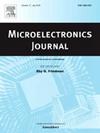An intelligent thermo-mechanical coupling collaborative design technique for 2.5D chiplet heterogeneous integration (CHI) system
IF 1.9
3区 工程技术
Q3 ENGINEERING, ELECTRICAL & ELECTRONIC
引用次数: 0
Abstract
An intelligent thermo-mechanical coupling collaborative design technique for 2.5D chiplet heterogeneous integration (CHI) systems is proposed. Using a four-chiplet 2.5D CHI system as an example, a thermo-mechanical coupling simulation model is established to reduce computational load through Latin hypercube sampling and data-driven modeling, significantly improving design efficiency. A GA-BPNN is developed to map design parameters to performance parameters, enabling fast and reliable performance prediction. An improved PSO-LDIW algorithm is employed for multi-physics collaborative optimization, with results verified via finite element analysis. The proposed method effectively reduces maximum temperature and stress, with optimization deviations below 1.006%, providing an efficient solution for optimizing thermal and mechanical performance in high-density chip systems and offering insights for multi-domain collaborative design.
2.5D晶片异质集成(CHI)系统的智能热-机械耦合协同设计技术
提出了一种面向2.5D芯片异质集成(CHI)系统的智能热-机械耦合协同设计技术。以四晶片2.5D CHI系统为例,通过拉丁超立方体采样和数据驱动建模,建立了热机耦合仿真模型,减少了计算量,显著提高了设计效率。采用GA-BPNN将设计参数映射到性能参数,实现了快速、可靠的性能预测。采用改进的PSO-LDIW算法进行多物理场协同优化,并通过有限元分析验证了优化结果。该方法有效地降低了最高温度和应力,优化偏差小于1.006%,为高密度芯片系统的热力学性能优化提供了有效的解决方案,并为多领域协同设计提供了见解。
本文章由计算机程序翻译,如有差异,请以英文原文为准。
求助全文
约1分钟内获得全文
求助全文
来源期刊

Microelectronics Journal
工程技术-工程:电子与电气
CiteScore
4.00
自引率
27.30%
发文量
222
审稿时长
43 days
期刊介绍:
Published since 1969, the Microelectronics Journal is an international forum for the dissemination of research and applications of microelectronic systems, circuits, and emerging technologies. Papers published in the Microelectronics Journal have undergone peer review to ensure originality, relevance, and timeliness. The journal thus provides a worldwide, regular, and comprehensive update on microelectronic circuits and systems.
The Microelectronics Journal invites papers describing significant research and applications in all of the areas listed below. Comprehensive review/survey papers covering recent developments will also be considered. The Microelectronics Journal covers circuits and systems. This topic includes but is not limited to: Analog, digital, mixed, and RF circuits and related design methodologies; Logic, architectural, and system level synthesis; Testing, design for testability, built-in self-test; Area, power, and thermal analysis and design; Mixed-domain simulation and design; Embedded systems; Non-von Neumann computing and related technologies and circuits; Design and test of high complexity systems integration; SoC, NoC, SIP, and NIP design and test; 3-D integration design and analysis; Emerging device technologies and circuits, such as FinFETs, SETs, spintronics, SFQ, MTJ, etc.
Application aspects such as signal and image processing including circuits for cryptography, sensors, and actuators including sensor networks, reliability and quality issues, and economic models are also welcome.
 求助内容:
求助内容: 应助结果提醒方式:
应助结果提醒方式:


